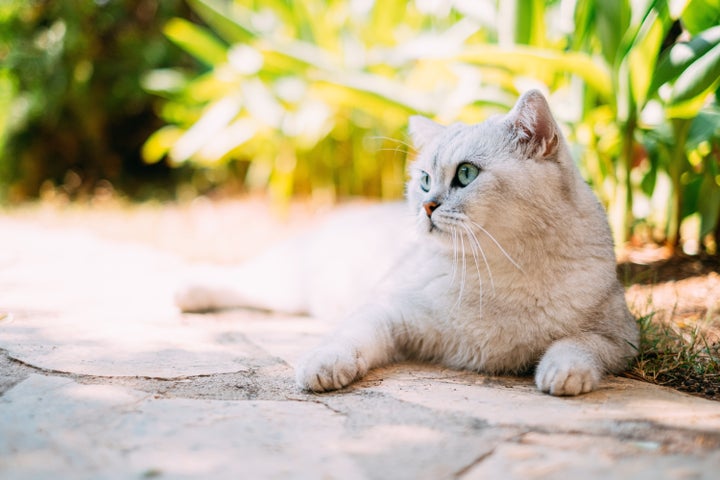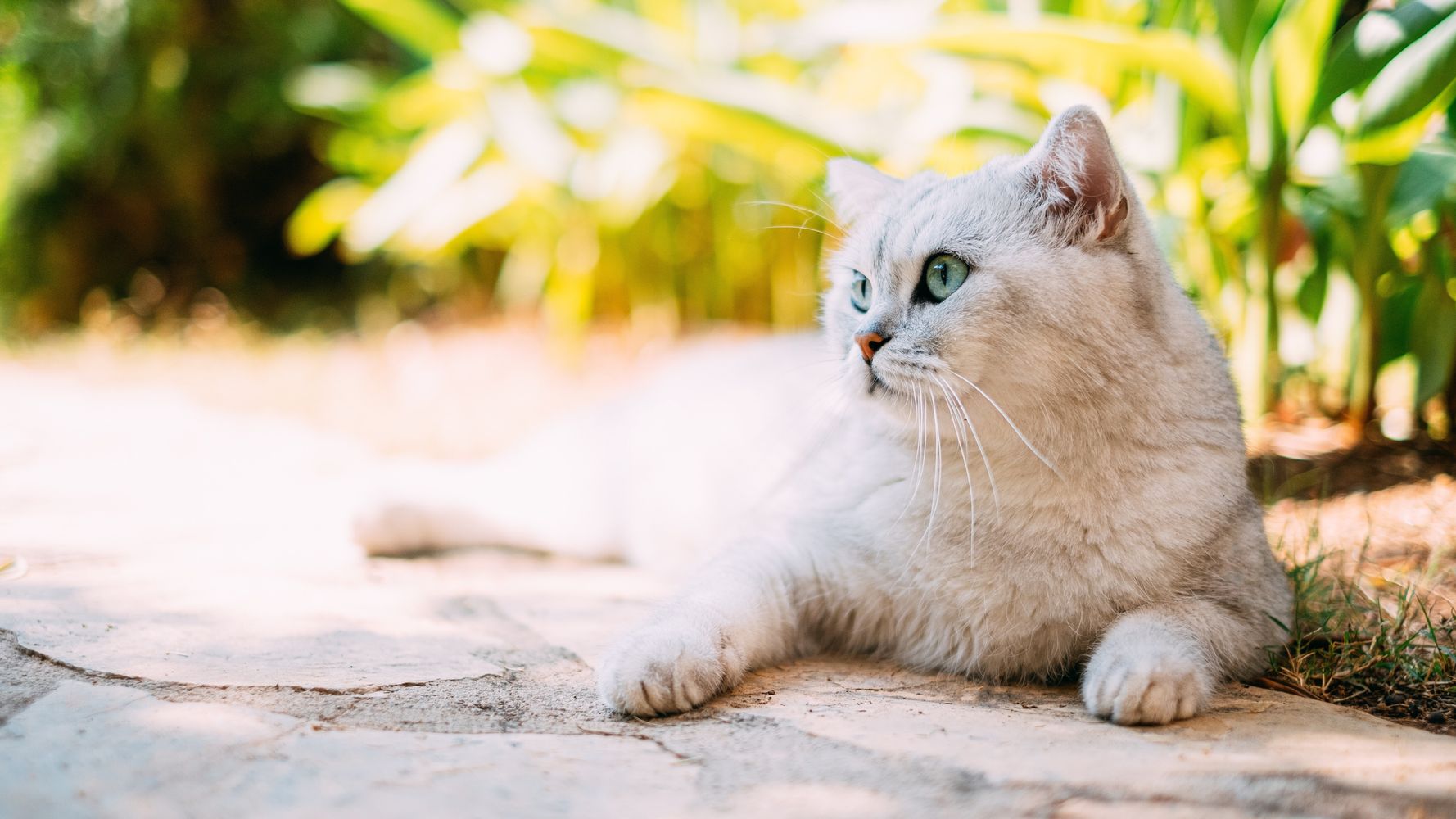[ad_1]
As heat waves and record-setting temperatures make headlines around the world, people are doing what they can to stay cool. The situation is even more challenging for those with pets.
Although we often associate dogs with outdoor play, many cats also enjoy spending time outside, and some even go for regular walks with their humans. But is it safe to take your feline friends out of the house in these conditions? And how can you ensure they remain healthy and happy when you do?
Below, pet experts break down what you need to know about letting your cats out in the heat.
Pay attention to rising temperatures
“On hot days, heat stroke is a very serious concern in cats, not just dogs,” said cat behaviorist Mieshelle Nagelschneider, owner of the Cat Behavior Clinic.
Once temperatures move into the 80s, it can be a problem for cats. Heat in the 90s and above poses even more serious risk. Not only should they not go outside in high heat, but inside the home, the air conditioner should be used. “Many owners leave for work and leave their cats in sweltering conditions, which can be dangerous,” Nagelschneider said.
To determine if it’s too hot for your cat to go outside, take note of heat advisories and severe weather forecasts. Don’t just look at the temperature but the heat index, or real feel, as well.
“From a welfare perspective, studies indicate that cats’ ‘thermoneutral zone’ ― the temperatures at which cats can regulate their body temperature with the least effort ― is 86 to 97 degrees,” said Annie Valuska, a senior pet behavior scientist at Purina. “Even if the temperature outside is lower than 97, owners should also keep in mind that other factors, such as the intensity of the sun and the humidity level, can contribute to it feeling warmer outside than the actual temperature.”
Ensure they have water and shade
“If your cat does go outside on a very hot day, make sure there is adequate water (ideally cold) available for them to drink and that a shady cool area is accessible for them to sit in,” said Dr. Michelle Meyer, president of the American Association of Feline Practitioners. “Keeping out of the sun and in the cooler shade can allow them to cool off. Cats can tolerate the heat a bit better than dogs ― they love to sit in the sunny spots while indoors ― but it’s important to note that they can suffer from overheating as well.”
Try to let them out during cooler times of day, like early in the morning and in the evening. Give them plenty of fresh, clean water and use a bowl that isn’t metal, as that can get overheated in the scorching temperatures.
“Do not allow pets to drink from standing water outside (in bird baths, puddles, creeks, old tires, etc.) as they can be exposed to life-threatening bacteria and parasites,” said Dr. LaCheryl Ball, a veterinarian with the American Society for the Prevention of Cruelty to Animals’ community medicine team.
You’ll also want to make sure your cat is able to get back inside easily in the event that they get too hot. Consider investing in a cooling mat where they can seek relief as well.
“Outdoor cats may seek shelter in unlikely places in an attempt to stay cool, so carefully check for cats under cars before driving and in open sheds and garages before locking them up,” Valuska advised.

AegeanBlue via Getty Images
Protect their paws
“Walks aren’t just for dogs ― cats enjoy their strolls too,” said Twila McGee, CEO and founder of NOLAs Finest Pet Care.
She recommended having a properly fitted harness for your cat’s walks so that you can keep them safe and supervised. Make sure their paws are protected as well.
“Sidewalks and pavement can be extremely hot and cause burns to the paw pads,” said Dr. Emily Cross, a veterinarian at Purina. “It is best to have animals in the grass versus on hot surfaces. You can touch the sidewalk or pavement with your hand or bare foot. If it feels hot to you, it is too hot for them as well.”
Some cats can wear little booties or socks, but your kitty might not tolerate them. You can also buy or make your own paw wax, which can offer some protection. Still, the best option is limiting their time outside in sweltering temperatures.
“As pets are close to the ground, the hot asphalt can also contribute to their body heating up very quickly,” Ball said. “Pets with paw pad burns will limp, refuse to walk, and the top layer of skin will look like it’s blistering and peeling, or may even be absent. Hot asphalt can burn the sensitive paw pads on our pets. Always check for redness between toes and cracks on your pet’s paw pads.”
Pay attention for signs of overheating
“Just like dogs, a cat’s only means of cooling itself off is by panting and sweating through its paws,” Nagelschneider noted. “You never want to see your cat pant, even during a play time. You’ve overexerted your cat if you see this.”
Indeed, panting is not typical behavior in cats, so if you observe this, you should immediately move them to an air-conditioned and shaded place and give them water. Contact your vet, especially if they show other signs of heat stroke, like vomiting, dizziness, lethargy, drooling or bright red gums. Look out for sweaty paw prints as well.
“Have an action plan in place so you can act early if you see a problem,” Valuska said. “Get to know your cat’s normal behaviors during milder temperatures so that you’re better equipped to notice a change in behavior indicating they may not be coping well with heat. Cat behavior changes can be subtle, so close observation of your cat is key.”
Consider your individual cat’s needs
“Young cats and kittens and older cats are especially susceptible to heat stroke,” Nagelschneider said. “Overweight cats and breeds with shorter faces like Persians are at higher risk for heat stroke.”
Certain breeds of cat are brachycephalic ― which means their skull bones are shorter, giving them that flat-faced appearance. These breeds, which include Persian, Himalayan, and Burmese cats, tend to have breathing issues and don’t pant as effectively, so you’ll want to pay extra-close attention to them in hot environments and keep them inside when possible.
Don’t forget about sunscreen
“Like humans, pets can also get sunburned, especially on noses, ears and any exposed skin,” Ball said. “This should be considered for any pet, but especially hairless cats.”
Avoid putting sunscreen that was formulated for humans on your pets.
“Check with your vet about recommendations for a cat-safe sunscreen for noses and ears, especially on cats with white fur,” Valuska advised.
Ball also recommended antiparasitic products (like preventative sprays, drops, and oral medications) to ward off fleas, ticks and worms during the summer months.
“Always be sure to read the labels before applying to your pet,” she said.
Feed them hydrating meals
“Cats don’t have a thirst drive like humans and dogs do, so they may need extra encouragement to stay hydrated,” Valuska said. “Consider supplementing their diet with wet food or liquid complements and making their water more attractive by investing in a ‘cat fountain’ and sanitizing their water bowl regularly.”
In higher temperatures, food might spoil more quickly and attract bugs, so be sure to change it more often.
“Owners can help encourage extra water intake ― which is especially important in older cats to prevent dehydration ― by making sure a good supply of fresh water is always available,” said Dr. Nathalie Dowgray, head of International Cat Care’s veterinary division, the International Society of Feline Medicine. “This includes multiple bowls in different locations around the home, away from food bowls and litter trays. Most cats prefer wide and shallow bowls filled to the brim.”
Dowgray also recommended adding flavor to their water with the liquid left over from a can of tuna in spring water or from poaching a piece of chicken or fish.
“In hot weather, cats often won’t eat during the day but will eat at night or in the early morning when it’s cooler, so you might need to adjust your feeding times to suit your cat’s preferences,” Dowgray added.
Don’t shave them
“Please, do not shave your cat!” urged Linda Hall and Rita Reimers, co-founders of the Cat Behavior Alliance. “Many people think it will make the cat cooler, but that fur protects them. The only time we suggest shaving is in case of bad matting where you have no choice.”
If you have a shaved cat, refrain from taking them out in the sun, as their skin is fragile and susceptible to sunburn.
“Fur protects skin from heat and sunburn, so consider a trim instead,” McGee advised. “Consult with your groomer about summer cuts.”
Regular grooming practices like brushing can also remove shedding hair and help your cat feel more cool and comfortable.
“For pet parents that have cats with beautiful long fur such as Maine coons and Norwegian forests, make sure to brush daily,” McGee added.
[ad_2]
Source


